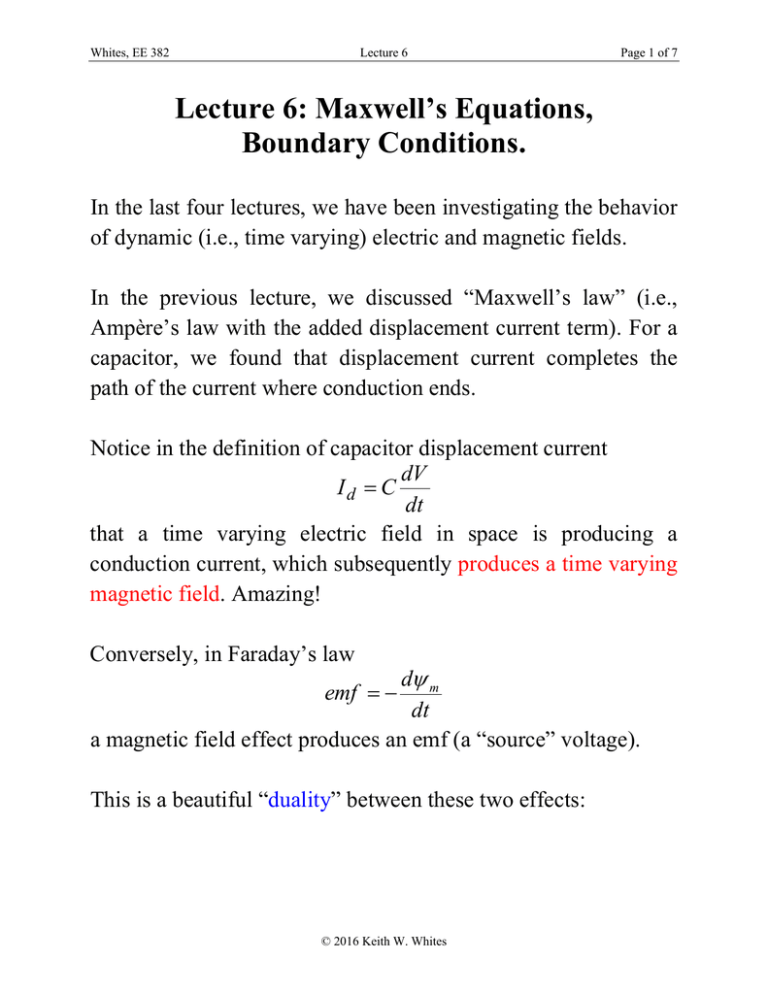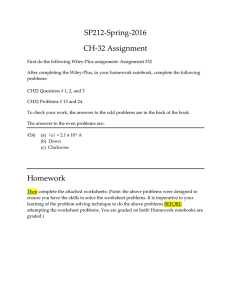Lecture 6: Maxwell`s Equations, Boundary Conditions.
advertisement

Whites, EE 382 Lecture 6 Page 1 of 7 Lecture 6: Maxwell’s Equations, Boundary Conditions. In the last four lectures, we have been investigating the behavior of dynamic (i.e., time varying) electric and magnetic fields. In the previous lecture, we discussed “Maxwell’s law” (i.e., Ampère’s law with the added displacement current term). For a capacitor, we found that displacement current completes the path of the current where conduction ends. Notice in the definition of capacitor displacement current dV Id C dt that a time varying electric field in space is producing a conduction current, which subsequently produces a time varying magnetic field. Amazing! Conversely, in Faraday’s law d m dt a magnetic field effect produces an emf (a “source” voltage). emf This is a beautiful “duality” between these two effects: © 2016 Keith W. Whites Whites, EE 382 Lecture 6 Maxwell’s law: Faraday’s law: Page 2 of 7 E t induces B t t B t induces E t t Since a time varying electric field produces a magnetic force and vice versa, we now speak of an electro-magnetic field, rather than electric and magnetic fields separately. Because of this duality, we will see shortly that electromagnetic signals can propagate as waves! It is because of this fantastic circumstance that there exists light, radio communications, satellite remote sensing, RADAR, fiber optic networks, CAT scans, etc. Maxwell’s Equations The laws of classical electromagnetics can be neatly summarized into a concise collection called Maxwell’s equations. In point form, Maxwell’s equations read: Whites, EE 382 B t t D t H t J t t D t v t B t 0 E t Lecture 6 Faraday’s law Ampère’s law Gauss’ law, I Gauss’ law, II In integral form, Maxwell’s equations read d E t dl B t ds dt s c c s d D t ds J t ds dt s c c s s c D t ds v t dv s v v s B t ds 0 s v H t dl Page 3 of 7 Faraday’s law Ampère’s law Gauss’ law, I Gauss’ law, II In addition, the continuity equation (conservation of charge) reads in point form: t J t v t and in integral form d J t ds v t dv dt s v v s Whites, EE 382 Lecture 6 Page 4 of 7 These laws describe all of classical (i.e., non-quantum mechanical) electromagnetism. Maxwell’s equations are an amazingly short and concise set of equations. However, these equations are usually difficult to solve for real-world problems. Interdependent Equations As it turns out, not all of these equations are independent for dynamic fields. For example, if we take the divergence of Ampère’s law: D H 0 J t we find that it reduces to J v t which is the continuity equation. There are other examples of interdependencies among Maxwell’s equations for dynamic fields. Constitutive Equations For dynamic electromagnetism, the static constitutive equations are still applicable: Whites, EE 382 Lecture 6 Page 5 of 7 D t E t B t H t J t E t However, for sinusoidal steady state problems, the material parameters are often a function of frequency. That is Boundary Conditions The boundary conditions for dynamic EM fields remain the same as were derived earlier in EE 381 for static fields: â21 Tangential components – aˆ21 E2 t E1 t 0 aˆ21 H 2 t H1 t J s K Normal components – aˆ21 D2 t D1 t s t aˆ21 B2 t B1 t 0 Whites, EE 382 Lecture 6 Page 6 of 7 Example N6.1: The electric field E x, t aˆ z Eo cos t x V/m exists in free space. Determine H t and consistent with this electric field and all of Maxwell’s equations. From Faraday’s law: E aˆ x x 0 Therefore, By or So, aˆ y B . For this example t aˆ z 0 y 0 E B 0 aˆ y z z x t Ez Ez Eo cos t x t x x Eo 1 sin t x t x x By Eo sin t x t By E cos t x C o The constant C cannot be a function of time. It is often taken as zero for dynamical problems if there are no sources present for constant magnetic fields. Therefore, H t aˆ y E cos t x [A/m] 0 o Whites, EE 382 Lecture 6 From Ampere’s law: H aˆ x x 0 aˆ y Page 7 of 7 D J 0 . Then t aˆ z 0 y Hy H y E ˆ 0 a z 0 z x t 0 Therefore, Eo cos t x 0 Eo cos t x x 0 t Ez or t x t x Eo 1 sin t x 0 Eo 1 sin t x 0 x t So that 2 0 or 0 0 [rad/m] 0 D 0 E 0 Ez 0. z consistent with Maxwell’s equations. B B y 0 . consistent with Maxwell’s equations. y

